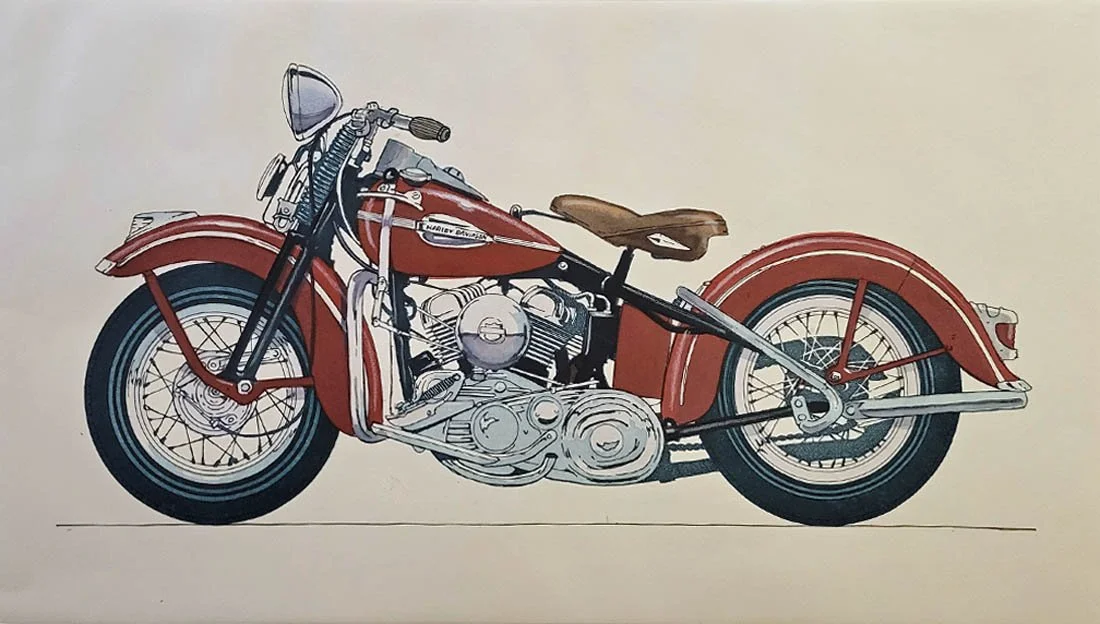 Image 1 of 1
Image 1 of 1


1940 Harley Davidson etching by Allan Stephenson
Artist: Allan Stephenson, ENGLAND
Media: Etching
Edition: 200
Image Size: 17" x 9 1/2"
Description:
1940 Harley Davidson etching by Allan Stephenson Allan Stephenson’setchings of classic cars, bicycles, motorcycles and airplanes draw from his experienceboth as an illustrator and a young car-spotter who would doodle cars on hisexercise book at school instead of attending to the lessons at hand. He livedat the time in 1950’s England, so his sketches were of Triumphs, the MG’s, theHealeys and the Jaguars that he saw almost every day. Once in a while, he wouldsee an exotic and foreign Alfa, BMW or Porsche – even a gigantic Hudson orChrysler. During the 1960’s hewitnessed the homogenization of the auto industry. Many small, independentcompanies would be swallowed up by larger corporations, and along with that –the disappearance of unique styling and engineering, giving way to what we havetoday – a handful of giant manufacturers producing cars barely discernable fromeach other. So, Allan refers backto the days when the cars, bikes and planes were very different from eachother- when the designers were reaching and experimenting. Some not so successfully, but othersproducing timeless classics of design. For the most part, they were handmade ofmaterials such as wood, hammered sheet metal, rivets, spoked wheels, gleamingexhaust pipes, huge headlamps, flared fenders, running boards, split windscreenand enameled badges with mascots riding ahead on the radiator caps. They may not have been so silky smooth,seamless and reliable as today’s mass-manufactured car, but they made up for itby having immense character and charm! Edition number 89
Artist: Allan Stephenson, ENGLAND
Media: Etching
Edition: 200
Image Size: 17" x 9 1/2"
Description:
1940 Harley Davidson etching by Allan Stephenson Allan Stephenson’setchings of classic cars, bicycles, motorcycles and airplanes draw from his experienceboth as an illustrator and a young car-spotter who would doodle cars on hisexercise book at school instead of attending to the lessons at hand. He livedat the time in 1950’s England, so his sketches were of Triumphs, the MG’s, theHealeys and the Jaguars that he saw almost every day. Once in a while, he wouldsee an exotic and foreign Alfa, BMW or Porsche – even a gigantic Hudson orChrysler. During the 1960’s hewitnessed the homogenization of the auto industry. Many small, independentcompanies would be swallowed up by larger corporations, and along with that –the disappearance of unique styling and engineering, giving way to what we havetoday – a handful of giant manufacturers producing cars barely discernable fromeach other. So, Allan refers backto the days when the cars, bikes and planes were very different from eachother- when the designers were reaching and experimenting. Some not so successfully, but othersproducing timeless classics of design. For the most part, they were handmade ofmaterials such as wood, hammered sheet metal, rivets, spoked wheels, gleamingexhaust pipes, huge headlamps, flared fenders, running boards, split windscreenand enameled badges with mascots riding ahead on the radiator caps. They may not have been so silky smooth,seamless and reliable as today’s mass-manufactured car, but they made up for itby having immense character and charm! Edition number 89






